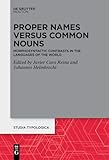Proper Names versus Common Nouns : Morphosyntactic Contrasts in the Languages of the World / ed. by Javier Caro Reina, Johannes Helmbrecht.
Material type: TextSeries: Studia Typologica [STTYP] : Beihefte / Supplements STUF - Sprachtypologie und Universalienforschung / Language Typology and Universals ; 29Publisher: Berlin ; Boston : De Gruyter Mouton, [2022]Copyright date: ©2022Description: 1 online resource (VII, 263 p.)Content type:
TextSeries: Studia Typologica [STTYP] : Beihefte / Supplements STUF - Sprachtypologie und Universalienforschung / Language Typology and Universals ; 29Publisher: Berlin ; Boston : De Gruyter Mouton, [2022]Copyright date: ©2022Description: 1 online resource (VII, 263 p.)Content type: - 9783110672473
- 9783110672749
- 9783110672626
- 400
- P217.3 .P76 2022
- online - DeGruyter
- Issued also in print.
| Item type | Current library | Call number | URL | Status | Notes | Barcode | |
|---|---|---|---|---|---|---|---|
 eBook
eBook
|
Biblioteca "Angelicum" Pont. Univ. S.Tommaso d'Aquino Nuvola online | online - DeGruyter (Browse shelf(Opens below)) | Online access | Not for loan (Accesso limitato) | Accesso per gli utenti autorizzati / Access for authorized users | (dgr)9783110672626 |
Frontmatter -- Contents -- Acknowledgements -- Morphosyntactic contrasts between proper names and common nouns: an introduction -- Personal names versus common nouns -- The definite article with personal names in Romance languages -- River names -- Proper names with and without definite articles: preliminary results -- On personal names in construct states in Modern and Biblical Hebrew -- Von Heidel- nach Bamberg, von Eng- nach Irland? ‘From Heidel- to Bamberg, from Engto Ireland?’ -- D-marking on Basque personal names from a synchronic and diachronic perspective -- On Special Onymic Grammar (SOG): Definiteness markers in Fijian and selected Austronesian languages
restricted access online access with authorization star
http://purl.org/coar/access_right/c_16ec
Recent research has shown that proper names morphosyntactically differ from common nouns in many ways. However, little is known about the morphological and syntactic/distributional differences between proper names and common nouns in less known (Non)-Indo-European languages. This volume brings together contributions which explore morphosyntactic phenomena such as case marking, gender assignment rules, definiteness marking, and possessive constructions from a synchronic, diachronic, and typological perspective. The languages surveyed include Austronesian languages, Basque, English, German, Hebrew, and Romance languages. The volume contributes to a better understanding not only of the contrasts between proper names and common nouns, but also of formal contrasts between different proper name classes such as personal names, place names, and others.
Issued also in print.
Mode of access: Internet via World Wide Web.
In English.
Description based on online resource; title from PDF title page (publisher's Web site, viewed 25. Jun 2024)


